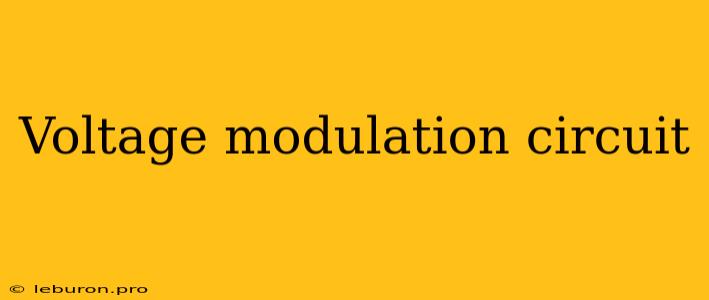Voltage modulation circuits are essential components in various electronic systems, enabling precise control and manipulation of voltage signals. These circuits play a crucial role in applications ranging from power electronics to signal processing. By adjusting the amplitude, frequency, or phase of a voltage waveform, voltage modulation circuits allow for efficient energy transfer, signal amplification, and the creation of complex waveforms. This article delves into the fundamental principles, types, applications, and advantages of voltage modulation circuits, providing a comprehensive understanding of their significance in modern electronics.
Understanding Voltage Modulation Circuits
Voltage modulation refers to the process of altering the voltage of a signal in a controlled manner. This alteration can involve changes in amplitude, frequency, or phase, resulting in a modulated output signal. Voltage modulation circuits are designed to perform these modifications using various techniques, depending on the desired application. These circuits typically consist of active components such as transistors, operational amplifiers (op-amps), or specialized integrated circuits, along with passive elements like resistors, capacitors, and inductors.
Working Principle of Voltage Modulation Circuits
The operation of voltage modulation circuits relies on the interaction between an input signal and a control signal. The input signal is the voltage waveform that needs to be modulated, while the control signal determines the specific modulation parameters. For instance, in amplitude modulation, the control signal modifies the amplitude of the input signal, while in frequency modulation, it alters the frequency of the input signal.
Types of Voltage Modulation Circuits
Voltage modulation circuits can be classified into different types based on their modulation technique:
- Amplitude Modulation (AM): In amplitude modulation, the amplitude of the input signal is varied proportionally to the control signal. This technique is commonly used in radio communication, where the amplitude of a carrier wave is modulated by an audio signal.
- Frequency Modulation (FM): Frequency modulation involves altering the frequency of the input signal in accordance with the control signal. FM is widely used in radio broadcasting, as it provides better noise immunity than AM.
- Pulse Width Modulation (PWM): Pulse width modulation is a digital technique that controls the width of pulses in a square wave signal. By adjusting the pulse width, the average voltage of the signal can be effectively modulated. PWM is widely employed in power electronics for applications like motor control and power supply regulation.
- Phase Modulation (PM): In phase modulation, the phase of the input signal is shifted according to the control signal. PM is used in various communication systems and is closely related to frequency modulation.
Applications of Voltage Modulation Circuits
Voltage modulation circuits find extensive use in a wide range of applications, including:
Power Electronics
- Motor Control: PWM techniques are essential for controlling the speed and torque of electric motors. By modulating the voltage applied to the motor, its rotational speed can be precisely adjusted.
- Power Supply Regulation: Voltage modulation is used in power supplies to regulate the output voltage and ensure stable operation.
- DC-DC Converters: These converters utilize voltage modulation to convert DC voltage from one level to another, enabling efficient energy transfer.
Signal Processing
- Signal Amplification: Voltage modulation circuits can be used to amplify weak signals by adjusting their amplitude.
- Signal Filtering: Modulation techniques can be employed to filter unwanted frequencies from a signal, isolating the desired components.
- Waveform Generation: Voltage modulation allows for the creation of complex waveforms, such as sine waves, square waves, and triangular waves.
Communication Systems
- Radio Communication: AM and FM modulation are fundamental techniques used in radio broadcasting and communication systems.
- Data Transmission: Modulation techniques enable the transmission of digital data over various communication channels, including wireless and wired networks.
Advantages of Voltage Modulation Circuits
Voltage modulation circuits offer several advantages, making them indispensable in various electronic systems:
- Precise Control: These circuits provide precise control over voltage parameters, enabling fine-tuning of system performance.
- Flexibility: Voltage modulation techniques offer flexibility in modulating different aspects of a signal, allowing for diverse applications.
- Efficiency: By efficiently manipulating voltage signals, these circuits contribute to energy savings and improved system efficiency.
- Noise Reduction: Some modulation techniques, such as FM, can significantly reduce noise interference, ensuring signal clarity.
Conclusion
Voltage modulation circuits are crucial elements in modern electronics, enabling the controlled modification of voltage signals for diverse applications. From power electronics to signal processing and communication systems, these circuits play a vital role in shaping the performance and functionality of countless electronic devices. By understanding the principles, types, and applications of voltage modulation circuits, engineers can effectively design and implement systems that leverage the advantages of these versatile components. As electronic technology continues to evolve, voltage modulation circuits will remain an essential cornerstone in driving innovation and enhancing the capabilities of electronic systems.
